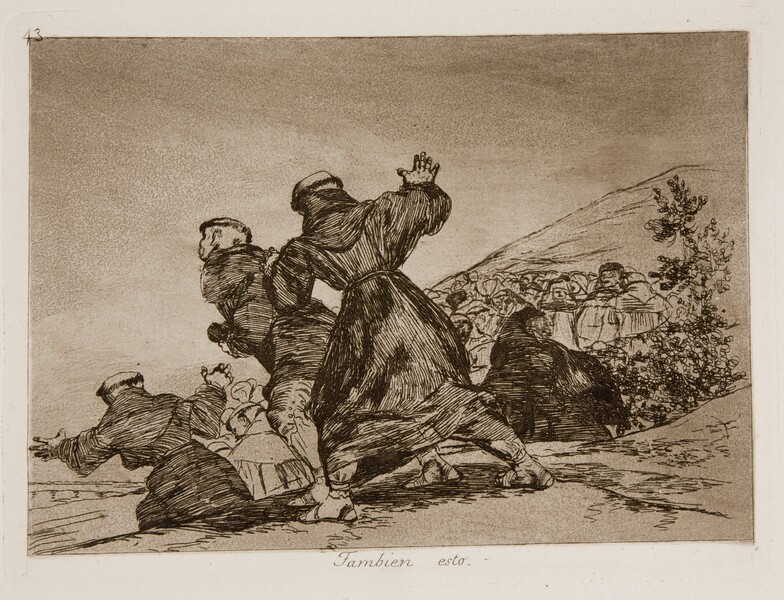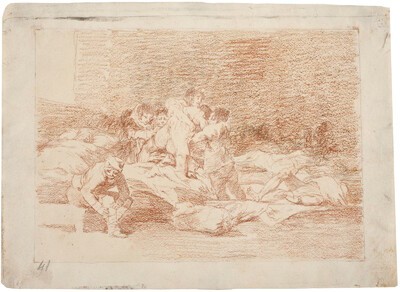- Cronología
- Ca. 1810 - 1812
- Dimensiones
- 165 x 236 mm
- Técnica y soporte
- Aguafuerte, punta seca y buril
- Reconocimiento de la autoría de Goya
- Undisputed work
- Ficha: realización/revisión
- 02 Dec 2010 / 28 Apr 2025
- Inventario
- 225
Goya (lower left-hand corner), 13 (lower left-hand corner).
See Sad presentiments of what must come to pass.
The second artist's proof bears Goya's signature on the lower left-hand corner.
The title was handwritten on the print by Goya in the first and only series that is known to have been printed at the time the works were created, which the artist gave to his friend Agustín Ceán Bermúdez. Therefore, the title was etched into the plate at a later date and left unchanged as of the first edition of the Disasters of War printed by the San Fernando Royal Academy of Fine Arts in Madrid in 1863, after the printing of the series in the possession of Ceán Bermúdez.
There is a surviving preparatory drawing for this print which is housed in the Prado Museum in Madrid.
In this print Goya continues the theme explored in prints no. 20, Treat them, then on to other matters and no. 24,They Can Still be of Use, in which the artist deals with the theme of those that assisted the wounded so that they could go forth into battle once more. Nevertheless, in this case the scene takes place inside what seems to be a hospital as opposed to outdoors as in the other prints.
In the foreground, a figure sitting on a bed appears to be tending his own wounds. Behind him lies a patient with a bandaged head, while a little further back there are two men watching a wounded man being moved. In the background of the print a doctor with his back to the viewer is attending to a figure on a stretcher. Next to him on the floor there is a body whose torso is covered but whose legs are dramatically exposed.
This print is clearly related to Goya's Plague Hospital perteneciente a la serie propiedad del marqués de la Romana. which belongs to the series of works belonging to the Marquis of la Romana. In both cases light plays an important role in the works: in the painting, a golden light bathes the figures in the room, while in the print Goya has created a lighter area in the upper section of the print, suggesting a source of light in that area. This method of illuminating the scene is also reminiscent of Yard with Lunatics in which Goya introduced a light high up in the composition that defines the contours of the upper section of the painting.
The plate is stored in the National Chalcography (cat. 276)
-
De grafiek van GoyaRijksmuseum RijksprentenkabinetAmsterdam1970from November 13th 1970 to January 17th 1971cat. 70
-
Francisco de GoyaMuseo d'Arte ModernaLugano1996exhibition celebrated from September 22nd to November 17th.cat. 25
-
Francisco Goya. Sein leben im spiegel der graphik. Fuendetodos 1746-1828 Bordeaux. 1746-1996Galerie KornfeldBern1996from November 21st 1996 to January 1997cat. 113
-
Francisco Goya. Capricci, follie e disastri della guerraSan Donato Milanese2000Opere grafiche della Fondazione Antonio Mazzottacat. 105
-
Goya. Opera graficaPinacoteca del Castello di San GiorgioLegnano2006exhibition celebrated from December 16th 2006 to April 1st 2007p. 63
-
Goya en tiempos de guerraMuseo Nacional del PradoMadrid2008consultant editor Manuela B. Mena Marqués, from April 14th to July 13th 2008cat. 86
-
Goya et la modernitéPinacothèque de ParisParís2013from October 11st 2013 to March 16th 2014cat.64
-
Goya, grabadorMadridBlass S.A.1918cat. 127
-
Goya engravings and lithographs, vol. I y II.OxfordBruno Cassirer1964cat. 145
-
Vie et ouvre de Francisco de GoyaParísOffice du livre1970cat. 1035
-
Catálogo de las estampas de Goya en la Biblioteca NacionalMadridMinisterio de Educación y Cultura, Biblioteca Nacional1996cat. 226
-
ParísPinacoteca de París2013p. 132
-
Goya. In the Norton Simon MuseumPasadenaNorton Simon Museum2016pp. 114-151

